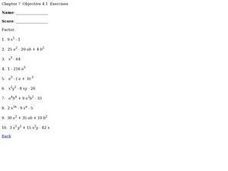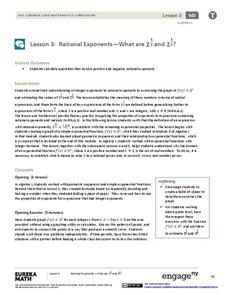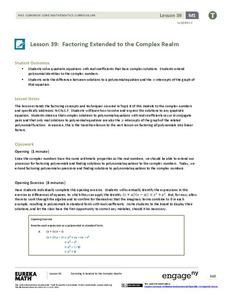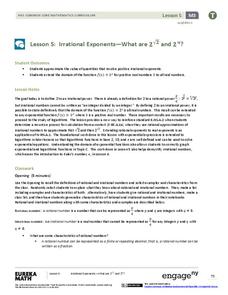Curated OER
Rational Numbers
In this rational numbers instructional activity, 9th graders solve and complete 12 different problems by dividing each equation. First, they use the division rules given at the top of the sheet to determine how they are going to solve...
Curated OER
Pattern Search
Third graders review the commutative and associative property in mathematics. Using a worksheet, they work together to identify the patterns between the 32 triangles. To end the lesson, they create their own array and exchange it with...
Curated OER
Chapter 7 - Objective 4.1 - Factoring
In this factoring worksheet, students combine like terms and simplify polynomials by factoring. This one-page worksheet contains ten problems.
Curated OER
Chapter 7 - Objective 1.1 Polynomials
In this polynomial learning exercise, students factor polynomials. Equations contain two to three terms, with one to two different variables. This one-page learning exercise contains ten problem.
Curated OER
Adding & Subtracting Polynomials
In this adding and subtracting polynomials worksheet, learners simplify each of ten problems using a vertical format for their work and response. They first group like terms together and add them. Students then remove the parentheses and...
Curated OER
Solving Linear Equations
In this linear equations learning exercise, learners solve six linear equations and check their work. Then they translate the next 4 problems into an equation and solve those too. Students first combine like terms when necessary and then...
Curated OER
The Distributive Property #5
In this distributive property worksheet, students simplify 36 expressions. Students add and multiply variables using the distributive property.
Curated OER
Chapters 12 - 14 Word Search Puzzle
In this mathematical concepts worksheet, students after discussing and reviewing about math expressions and equations, locate and circle nine key terms within a word search puzzle.
Curated OER
Identity and Equality Properties
In this identity and equality properties worksheet, students solve and complete 20 various types of problems. First, they name the property illustrated by each statement. Then, students evaluate each expression and name the property used...
Curated OER
New York State Testing Program: Mathematics Book 1, Grade 4 2007
In this 4th grade math standardized test practice worksheet, students solve 30 multiple choice math problems based on New York academic standards.
Curated OER
New York State Testing Program - Mathematics Test Book 1 6th Grade
In this 6th grade math instructional activity, 6th graders solve 25 multiple choice questions. Students determine coordinate of figures, use units of measure, expand exponents, etc.
Curated OER
New York State Testing Program Mathematics Book 1 Grade 7
In this grade 7 math knowledge test, 7th graders complete 30 multiple choice problems from a wide variety of math skills.
Curated OER
Rational Numbers
In this Algebra I worksheet, 9th graders identify properties from the real number system and use the distributive property to collect simplify expressions with parentheses. The one page interactive worksheet contains five multiple...
Curated OER
New York State Testing Program Grade 6
For this sixth grade mathematics worksheet, 6th graders are provided with questions that are reflective of the grade level expectations for New York State. The twenty page worksheet contains twenty-five multiple choice...
EngageNY
Rational Exponents—What are 2^1/2 and 2^1/3?
Are you rooting for your high schoolers to learn about rational exponents? In the third installment of a 35-part module, pupils first learn the meaning of 2^(1/n) by estimating values on the graph of y = 2^x and by using algebraic...
National Security Agency
Multiple Representations of Limits
After an introductory activity to demonstrate the theory of a limit, additional activities approach a limit from graphical, numerical, and algebraic methods. The activity looks at the multiple ways of understanding and evaluating a...
EngageNY
Factoring Extended to the Complex Realm
A solution will work one way or another: find solutions, or use solutions to find the function. Learners use polynomial identities to factor polynomials with complex solutions. They then use solutions and the Zero Product Property to...
EngageNY
Why Were Logarithms Developed?
Show your class how people calculated complex math problems in the old days. Scholars take a trip back to the days without calculators in the 15th installment of a 35-part module. They use logarithms to determine products of numbers and...
EngageNY
The Graph of the Natural Logarithm Function
If two is company and three's a crowd, then what's e? Scholars observe how changes in the base affect the graph of a logarithmic function. They then graph the natural logarithm function and learn that all logarithmic functions can be...
EngageNY
Operations with Numbers in Scientific Notation
Demonstrate the use of scientific notation within word problems. The lesson presents problems with large numbers best represented with scientific notation. Pupils use these numbers to solve the problems in the 11th installment in a...
EngageNY
Using Sample Data to Compare the Means of Two or More Populations II
The 23rd segment in a series of 25 presents random samples from two populations to determine whether there is a difference. Groups determine whether they believe there is a difference between the two populations and later use an...
EngageNY
What Is a Trigonometric Identity?
Protect yourself from identity theft! Establishing a strong understanding of the Pythagorean identity allows learners to prove that sine^2x + cos^2x = 1. They then use the identity to find sine or cosine ratios given the other.
EngageNY
Irrational Exponents—What are 2^√2 and 2^π?
Extend the concept of exponents to irrational numbers. In the fifth installment of a 35-part module, individuals use calculators and rational exponents to estimate the values of 2^(sqrt(2)) and 2^(pi). The final goal is to show that the...
EngageNY
Building Logarithmic Tables
Thank goodness we have calculators to compute logarithms. Pupils use calculators to create logarithmic tables to estimate values and use these tables to discover patterns (properties). The second half of the instructional activity has...























